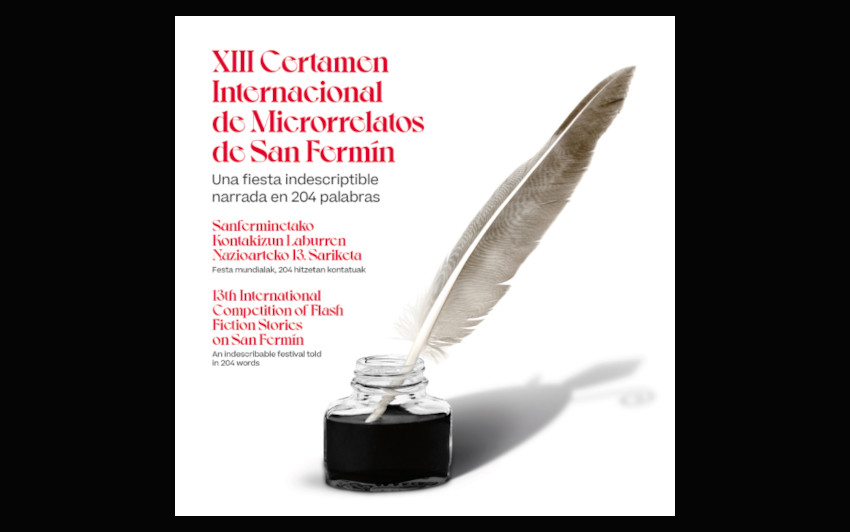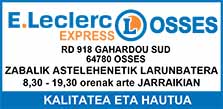Iruña-Pamplona, Navarre. In a second year marked by the pandemic, and nostalgia for festivities that were again postponed, the 13th edition of the San Fermin Short Story Contest, was held, organized by the San Fermin Blog. Quite an occasion to narrate experiences of the most popular Navarrese festivals. In the 2021 edition, the winning text was Divino (blanco como la cal), (Divino (White as Lime), by Javier Casado Mayayo; second place went to Miraculously Healed, by Wibo Sefeld; and third place went to "Ze birus eta ze birusondo!, by Garbiñe Zabala Zabaleta. Award Video.
Stressing the large international participation with a total of 423 authors from 22 countries participating, 21 short stories from Argentina, 9 from Colombia, 6 from Cuba, 6 from Venezuela, 5 from Mexico, 4 from Peru, and 4 from the Dominican Republic. 406 of these were presented in Spanish, 10 in Basque and 7 in English.
The Government of Navarre that publishes a book annually of the ten winning short stories translated into the contest’s three language, Spanish, Basque and English declared the San Fermin Short Story Contest a Cultural Activity of Social Interest in 2010. In this fun, fresh and creative way, with short, condensed and powerful stories, keeping the spirit of San Fermines alive.
Are you getting ready for next year’s contest?
Here are the top three stories in this year’s contest published on the BlogSanFermin.com.
1st Place: "Divino (blanco como la cal)," by Javier Casado Mayayo
Los había visto alguna vez por la tele, pero nunca creyó que se convertiría en uno de ellos. Cuando los entrevistaban, los escuchaba incrédulo, recién levantado de la cama y en el telediario de las tres, contando sus batallitas: que si cada vez es más difícil buscar el hueco, que si los guiris, que si cada año hay más masificación… No entendía cómo eran capaces de sacrificar una sola noche de juerga sanferminera para vivir la fiesta al otro lado de la barrera. «Hace falta valor», murmuraba su padre, mientras él ahogaba la resaca en un cuenco de caldo caliente.
Sin embargo, la pandemia lo cambió todo, también a él, y tres años después allí se encuentra, un 7 de julio a las ocho y pico de la mañana, dispuesto a atender a los medios. Ayer se acostó pronto para descansar bien, y con los primeros rayos de sol se ha echado a la calle, periódico en mano, para coger sitio entre codazos y empujones y correr los últimos metros hasta la arena. Envuelto en sudor y todavía jadeante, abre el diario por la sección de San Fermín y se dispone a disfrutar de la primerísima línea de playa conquistada a orillas de Salou.
2nd Place: "Miraculously healed," by Wibo Sefeld
It just seemed a bad dream but it wasn´t. I felt more dead than alive when I was taken to the hospital by the beginning of April. The only living record I´ve got before losing consciousness is the shape of my nurse. —Don’t worry, I´m Fermín, everything will be all right —was the first thing he told me. After that, darkness and nightmares, combined with an altered notion of time dominated by the daily struggle to recover my lungs, devastated by the virus. After three months, I finally woke up and the first thing I saw was a crowded Mercaderes bend on the TV screen. The bulls were crashing lightly against the fencing and my heart started to beat faster. The vintage images reminded me of the 70’s when I used to be there in Pamplona. Suddenly, I felt the strength coming back into my body and also the joy of living. I looked around with the anxious wish to thank Fermín for his good care. His colleagues smiled to me mysteriously. Astonished and intrigued, I found out that there had never been someone working with that name…
3rd Place: «Ze birus eta ze birusondo!» by Garbiñe Zabala Zabaleta
Geltokiko pertsianak, jaistean, sortzen duen burrunba oraindik airean dago, ilunpeko itzalak nagiak kentzen hasi direnean. Ile-motots eta Bizardun dira esnatzen lehenak; ondoren, Patata, Napoleon eta Garatxo; azkena, berriz, Caravinagre. Purrustadaka, isiltzen ez badira, kartoizko buru huts horiei su emango diela mehatxatuz. Gainontzeko kilikiek barre egin diote lagunaren burutazioari. Eta barre algarek zaldikoak esnatu dituzte. Ez hala erraldoiak eta buruhandiak, horien loa etetea ez baita erreza. Lehenengoek atseden luzea behar dutelako, gorputz garauak osasuntsu mantentzeko; eta bigarrenak ez daudelako ohituta langile ororen ordutegi goiztiarrera. Baina gaur ez da lotan geratzeko eguna, gaur inoiz baino argiago egoteko eguna da. Hori buruan eta maskuriak eskuan, elkar joka hasi dira garrasi pozgarri artean. Azkenean, zalapartak erraldoiak esnarazi dituen arte.
—Zer da hau? Aurten ez dago festarik! —dio Joshepamundak haserre.
Baina denok dakigu Caravinagre ez dela kukiltzen den horietakoa. Bekokia ximurtu eta hala dio:
—Ze birus eta ze birusondo! San Ferminekin bukatuko duenik ez da jaio! Ez dugu kalean ospatzerik, ezta jendearekin biltzerik ere. Baina bai etxean eta gure artean.
Hitz horiek nahikoa izan dira bihotzean daramaten suziriari su eman eta kalejira alaiari ekiteko: buruhandiak makila eskuan, erraldoiak dantzan eta kilikiak nahiz zaldikoak elkar joka .
Nola dakidan? pertsianaren bestaldetik inoizko gora san fermin itxaronpetsuena entzun dudalako.






 Send to a friend
Send to a friend Add comment
Add comment








